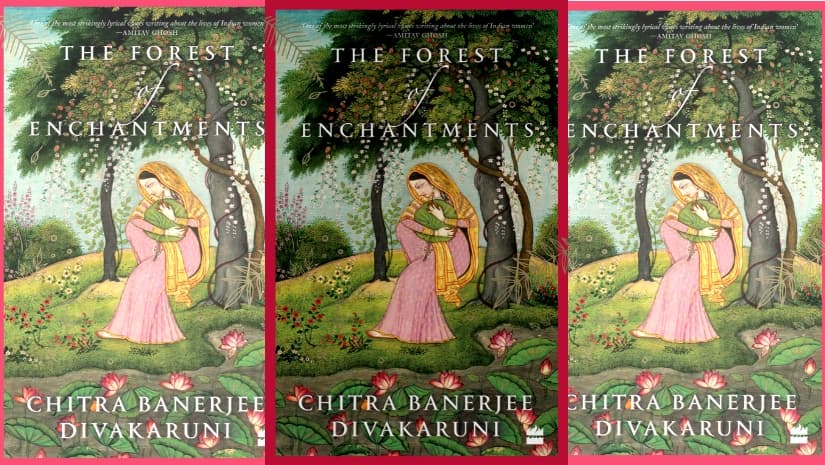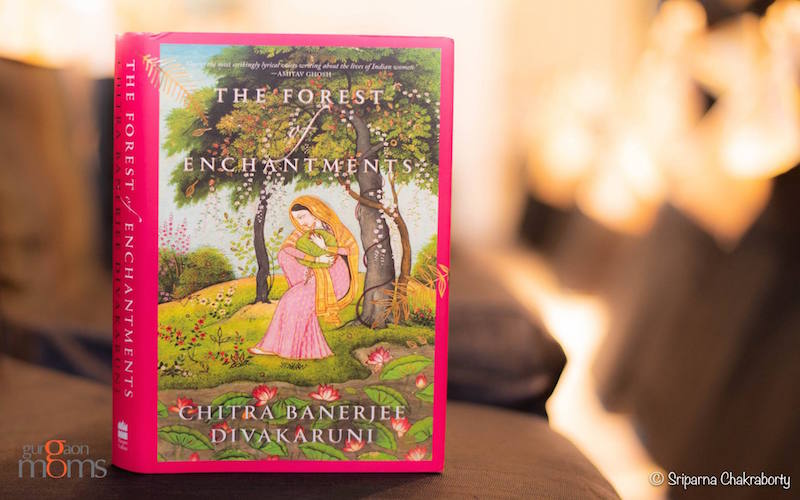The Forest of Enchantments is award-winning author Chitra Banerjee Divakaruni’s latest book and it re-examines the narrative of the Ramayana through Sita’s eyes. It sheds fresh light on a major Hindu epic, and attempts to question a woman’s place in society and reflects on the idea of female autonomy in a patriarchal community.
Book: Forest of Enchantments
Author: Chitra Banerjee Divakaruni
Publisher: Harper Collins (January 2019)
Genre: Feminist Fiction
The book takes on the ambitious project of outlining the contours of several shadowy female figures in the myth through Sita’s interactions with them- Kaikei, Ahalya, Surpanakha and Mandodari are all reconstructed in this manner. This in itself is an extremely attractive proposal as these women, their contributions and sacrifices are usually dismissed as trivial facts in the unfolding of the myth, their importance skimmed over and taken for granted.

Through them, Sita questions the boundary line between what is acceptable and unacceptable in a male-oriented world, which imposes a certain standard on the conduct of women and judges their actions from that bounded rationality. Forest of Enchantments uses Sita’s experiences to unravel the gendered double standard and when it is necessary for women to protest rather than accept their fate.
Sita questions the stark dichotomy between good and bad by conceding that each individual has their own understanding of dharma or just conduct. All that differs is perspective.
Unlike some authors, Divakaruni does not fictionalise any elements of the legend, so there are no unexpected twists and turns and the narrative is the foreseeable one most of us grew up with. Sticking to the original script has the advantage of refocusing the lens on the patriarchal interpretations in the Ramayana where the patriarchal acts are unchangeable – if this story had rewritten the epic, while giving one temporary gratification, it would leave you feeling curiously dissatisfied because you know it’s beyond the realm of reality in the actual narrative.
One of the first patriarchal interpretations it rejects is the idea of Ram as a stoic, self assured, man with no need for encouragement. Divakaruni-Banerjee’s Ram breaches the boundaries of stereotypical male and female attributes and confesses his vulnerability to Sita, sharing his fears with her. In a deeply interesting move, the narrative reworks Sita’s banishment to Valmiki’s ashram as a product of Ram’s own insecurities and childhood experiences, giving a different tint to the whole episode by making the literary legend fallible.
Sita also makes a remarkable effort to accept that the victors write history. She questions the stark dichotomy between good and bad by conceding that each individual has their own understanding of dharma or just conduct. All that differs is perspective. In doing so, she creates a cross-cutting bond amongst the female characters in the myth, who instead of being pitted against each other, become creatures dictated by their circumstances and own ideals of morality.
Banerjee’s Ramayana is deeply accessible in a way the original text is not – it humanises individuals we were brought up revering as Gods. Her examination of household dynamics and everyday hassles make the story distinctly relatable because it becomes evident that the intricacies of mortal interactions confuse even the divine – they face the same troubles we do, they feel the same things we do.
A retelling has immense potential to give power to those who are otherwise deprived of it and recast a narrative in a different light, reshaping the very context in which actions were interpreted, changing their meaning and basis. Chitra Divarkaruni hits the nail on the head with some aspects of her writing, but the Forest of Enchantments is a far cry from the feminist reshaping it is paraded as.
Also read: 7 Times The Women In Mahabharata Got Their Due
The most prominent evidence is in the fact that while the story is told through the perspective of a female, it actually caters to male narratives, with a few exceptions. The description of Sita’s journey seems to centre around Ram, with other stages (such as before her marriage) or other interactions in her life existing on the fringes. The bid to cross the fissure dichotomising gender falls short of achieving a middle ground, precisely because it takes on stereotypically female outlooks and feeds into a hierarchy of attributes that is biased towards what males traditionally value. It highlights and prizes male norms in a subtle way through Sita’s personality while covertly discouraging threats to the ideal.
Divakaruni Banerjee’s Sita protests largely internally and sometimes feebly externally. She mostly yields to Ram’s implacability and while she raises questions, she ends up swallowing her own answers. Her reminiscing remains largely personal, an internal dialogue which supposedly fuels her anger at the injustices women have to face-where does this anger dissipate then? The protagonist almost seems to start down a path to abandon it again in favor of the well travelled (socially respected) route.
Even Banerjee’s reconfiguration of the agniparkisha is less of a defiant escape from humiliation and more of an emphasis of the pativrata ideal of a married woman.
There is an unsettling emphasis throughout the book that Sita must endure the adversities in her life, she must be prepared to make sacrifices and accept the follies and mistakes of others. Even Banerjee’s reconfiguration of the
While Sita does refuse to go through a second

The main complaint with Divakaruni is that she failed to do justice to Sita’s perspective; in the end, Forest of Enchantments remained a tale about dharma, virtue and karma and not a channel for Sita’s voice and an expression for the oppression of the women in the Ramayan. The protagonist always seemed to live life for someone else rather than herself- first her father, then her husband and lastly for her sons and this devalued her autonomy in living her life simply for herself. Throughout the book, the female characters were defined via their use to the males – their value is gauged through their instrumentality to the men in the narrative.
Also read: Mahasweta Devi’s Draupadi As A Symbol Of Subaltern Defiance
Rather than a feminist recasting, it feeds into societal norms of victim-blaming and appreciates qualities from a male standpoint. While the author does try in several places to give Sita an independent voice, the book as a whole comes off as a shallow attempt at understanding the difficulties and dilemmas a woman faces. It leaves a powerless caricature where a complex woman was promised and reflects traditional narratives that extract impossible standards of conduct from females.
Featured Image Source: First Post
About the author(s)
Pallavi is a second year Political Science student struggling to graduate and her tumultuous relationship with her dog pushed her towards writing. She is an ardent lover of history who is trying to get rid of the internalized labels she grew up with.





One of the most beautiful books I have read in a really long time. I know for a fact I willl re read it many times.
Nice article thank u so much sharing for this article help us.
Downlode for latest Hindi song,Punjabi Song lyrics & Video
Nice artical
Great article.